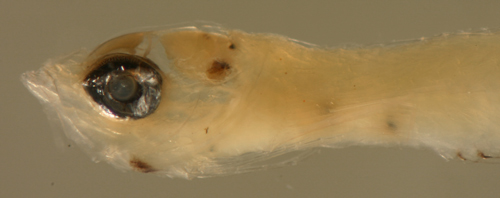
A Photographic GUIDE to the Late-Stage LARVAE of CORAL REEF FISHES
Under construction with daily additions, corrections, and refinements/May 2006
Return
to Ben's home page
Return
to home Introduction and Family List
skip to the allied blennioid families Blenniidae, Labrisomidae, or Chaenopsidae
Family Tripterygiidae
Triplefins are tiny blenny-like fishes that skate around over smooth rocks on reefs in the Caribbean. There is only one regional genus, Enneanectes spp., with five very similar-appearing species that share basic meristics and can only be separated by color patterns after settlement.
Larval tripterygiids resemble labrisomid larvae closely, differing mainly by having melanophores on the dorsal caudal peduncle and three separate dorsal fins. They can be recognized by their their pointed snout, long and continuous dorsal and anal fins with flexible spines (dorsal fins separated), a short and narrow caudal peduncle, long strand-like pelvic fins (usually straight, not curled up over the body), the absence of spines on the head, and light markings (basically a row of melanophores along the anal fin base, but including melanophores on the dorsal midline of the caudal peduncle). Larval tripterygiids have large round eyes, in contrast to many scarids, labrids, and gobiids in which the eye can be smaller or narrowed.
Triplefins have demersal brooded eggs and hatch as well-developed larvae around 4-5 mm. The early-stage larvae can be recognized by a moderately long and narrow body with a small pointed head, medium mouth, prominent jaw angle, rounded eye, no head spines, snout-to-vent length slightly less than half of body length, long fin bases, and early-forming posterior anal and dorsal fin elements. Pigmentation is distinctive, with a surface melanophore at the midline over the rear braincase, and a short row of two or three at the dorsal and ventral midlines of the caudal peduncle. In addition, there is a row of three ventral midline melanophores at the posterior end of the forming anal fin. There are internal melanophores at the sacculus, over the swim bladder, and around the gut near the vent.
Enneanectes spp. early-stage larva, 4.7 mm SL (San Blas, Panama, SB86-1227)




Diagnosis: Three dorsal fins with a fin ray count of D-III,XI-XII,6-8 A-II,14-16 pect 15-16 indicates Enneanectes spp. The five Caribbean species all overlap fin ray counts and can only be distinguished by color patterns after the larval stage. Separating larvae of these species would require DNA sequence analysis.
lapslidecleaner
sicydiumsagitta
cleanerdorsalembryoinsitu1
cleanersagittaembryoinsitu1
saginsituslidecleaner
lapinsituslidecleaner
Description: Body thi
Enneanectes spp. larva, 8.6 mm SL (internal melanophore pattern)(San Blas, Panama, SB86-509)

Return
to top of page
Return
to Ben's home page
Return
to home Introduction and Family List